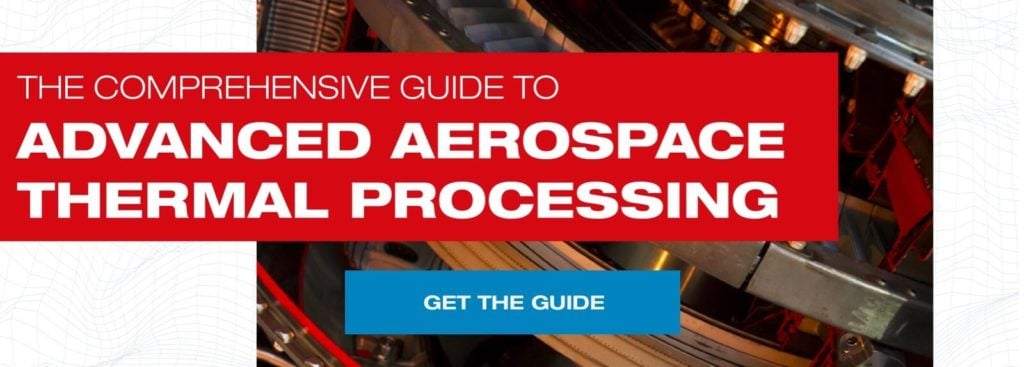Aerospace industry manufacturing processes are strictly regulated. The myriad standards that apply to countless aircraft components are necessary to keeping planes in the air and preserving the safety of crew, passengers and people and property on the ground.
One of the industry’s most important quality assurance principles is first article inspection (FAI)—the systematic inspection of new parts to ensure they’ll perform as designed.
All manufacturing and post-processing stages in the early life of a part are subject to FAI. Heat treatment-specific FAI requirements are just a small part of a much bigger process designed to guarantee that new aerospace components will stand up to the demands their service places on them.
What is first article inspection?
The aerospace, automotive, medical and other industries all feature FAI requirements. In general, these inspections (and the exhaustive documentation supporting them) entail the thorough investigation of parts pulled from the first-ever batch to verify that:
- The exact material specified for a given part was used.
- Manufacturing or finishing methods detailed in the specs were followed.
- Part characteristics that result from manufacturing or processing are within tolerances stated in the specs.
In the aerospace industry, SAE AS9102 standardizes the documentation that industry suppliers must provide to meet OEMs’ FAI requirements. According to SAE, the standard is meant to provide “objective evidence that all engineering design and specification requirements are properly understood, accounted for, verified and documented.”
Heat treaters (and any other provider at any stage in the aerospace manufacturing process) must submit three forms:
- Form 1 covers part number accountability and notes the part and subassemblies being inspected.
- Form 2 covers product accountability and accounts for materials, special processes and functional testing.
- Form 3 covers characteristic accountability, verification and compatibility evaluation. Information about how inspected parts compare against drawings is recorded on this form.
To better visualize what FAI documentation entails, consult this tip sheet.
FAI reporting for heat treaters
Because heat treatment of aerospace components is so critical to their end use, heat treatment documentation for FAI parts is quite exhaustive.
Every aspect of heat treatment is documented, including:
- The inspection of parts before they’re even processed to verify they meet initial tolerances stated in specs.
- Heat treatment parameters including type of treatment, how long the treatment lasts, how hot the furnace gets (and even how quickly or slowly that temperature is reached) and the way the part is quenched.
- Verifying post-treatment variables like hardness, tensile strength, yield strength and critical dimension characteristics against tolerances stated in specs.
That last point is extremely important. Heat treatment almost always distorts parts—it’s the price that comes with enhancing mechanical properties. First article inspections help heat treaters and customers determine whether specified processes will result in acceptable amounts of distortion or if design, material, manufacturing and processing specs need to change.
Completed FAI documents are forwarded to customers. They’ll add it to the pile of similar reports provided by upstream providers. The result is a massive collection of documents tracing every process in a newly-developed part’s production journey.
A partnership with Paulo is different
As a trusted aerospace and defense heat treater, Paulo excels in providing accurate and thorough FAI documentation in compliance with AS9102. In addition to providing the required FAI documents to customers, we keep digital copies of every record we produce as well as hard-copy backups stored in secure locations.
But the benefits of a partnership with Paulo go beyond good recordkeeping. Everyone has a hand in ensuring consistent quality, from quality team members, production staff, maintenance personnel and plant management. When it comes to our Quality Management System, everything is scrutinized. There’s nothing left unplanned. Our cross-functional team applies its heat treatment expertise to the information we gather about part design, material and manufacturing. This intensive review allows us to flag potential problems earlier in the process and, when possible, recommend upstream tweaks that will result in parts that pass inspection.
Then, we run heat treatments backed by our Product Information and Customer Service (PICS) software. This advanced system provides value to customers by recording process information in real time and alerting operators if furnace conditions such as pyrometry slip outside of the tolerances defined in treatment specs. This saves time and enhances our ability to troubleshoot potential problems.
Simply put, our job is to collect and act on information in ways that ensure that our heat treatments are successful and repeatable.
Consult our experts
If you want to learn more about our approach to FAI documentation, or have a part in development and want some guidance on heat treatment specs, contact us now..
For a deeper look into our approach to heat treating for critical aircraft components, read our Comprehensive guide to advanced aerospace thermal processing.



